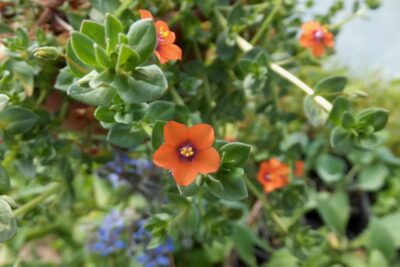
Does a plant of Scarlet Pimpernel by your greenhouse door warn you of incoming bad weather? There was only one way to find out, by growing some and observing. In the trial Anagallis arvensis turned out such a pretty thing I grow a pot or two every year, hanging pots which suit the trailing habit, and bring those small gorgeously formed richly coloured flowers closer. Though don’t touch the leaves, once considered a salad on the Continent it’s now thought allergenic to some so best be careful (tried some and you’re not missing much).
Scarlet Pimpernel is a native, a creeping annual from heaths and sand dunes, looking much like but seldom becoming a weed in our gardens. Oddly for a native these flowers have no honey to attract insects only pollen, and the foliage has been recorded sustaining only one Lepidoptera larvae, the Dwarf Cream Wave.
A sandy free draining compost with minimal feeding and abstemious watering mimics their origins, as does full sun even heat, these are not shade lovers but colonisers of hot sandy wastes. Ideally sow individually in small cells so the plants can be grown on with minimal disturbance other than potting up. Seed germinates best on the surface or just buried of preferably Ericaceous (lime free) sowing compost. The flowers soon start blooming, continually for months.

Scarlet Pimpernel as a weather glass was known to the ancient writer Pliny who noted there was also a Blue Pimpernel. Actually although brilliant scarlet there occasionally appear in the wild: blue, pink, lilac, even purple forms but unusually it seems never ever a white even though most other flowers have white variants. Eric Marsden-Jones experimented crossing these unusual coloured varieties and managed parti-coloured and even differently coloured flowers on the same plant, but never a white, curious. For the breeder or collector there are four native species with a half dozen garden varieties available.

And does it work, well the flowers are normally open during morning and early afternoon closing 2-3pm reopening about 7am. Thus they could only ever be any indication in the morning, when indeed they did sometimes close, but only when the weather was already heavily overcast -which was sort of enough of a warning anyway.










